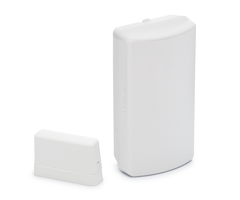Door & Window Alarm Sensors







Any proper security setup should use door and window sensors. After all, you will want to know if an intruder enters in through your front door or if they open your window. Once the door or window has been opened, the sensor will activate, and it will send a signal to the security system to fault the corresponding zone. From there, the programmed action will be conducted on the system, such as simply producing an audible chime or requiring that the system be disarmed within its entry delay period. This can be adjusted by setting the Response Type for that zone within programming.
Most door and window sensors work in similar ways. These devices typically feature a sensor and an included magnet. The sensor must be placed directly next to the magnet at all times in order to prevent the sensor from activating. If the magnet is separate from the sensor, the internal reed switch inside the sensor will be triggered, and the sensor will send a signal to the security panel to fault the zone. Once the magnet is returned to the sensor, the fault will be restored. However, the user may still need to disarm the system depending upon the Response Type that is programmed with the zone. To disarm, simply enter in a valid user code or the Master Code at the security panel.
When installing a door and window sensor, we typically advise users to place the magnet on the moving portion of the door or window and the sensor itself on the stationary frame. This will prevent the sensor from moving around and being damaged when the door or window is closed. Door and window sensors come in a variety of different sizes and colors, so there is an appropriate sensor for almost any type of door and window. For sliding doors, it may be necessary to use multiple sensors so that an opening from either end can be detected. Alarm Grid offers several helpful videos for installing a door and window sensor, and our support team is happy to provide online or phone support for monitored customers if necessary.
Door and window sensors can be surface-mounted or recessed. Surface-mounted sensors are easier to install, but they will be visible on the door or window. Most surface-mounted sensors can be fully installed with just double-sided sticky tape or a few screws. Recessed sensors are more discreet, as they will essentially be invisible on the door or window. However, they will require that holes be drilled into the door or window. This can make installation slightly more challenging. Door and window sensors can also be hardwired or wireless. A great part about wireless sensors is that they will not require you to run any wires from the system to the sensor. They can also be learned-in with most security systems with relative ease, making them a particularly good choice for DIY users. Our support team can help you determine the best door and window sensor for your needs if you are having trouble deciding.





